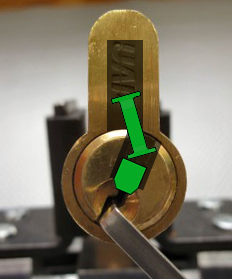
In North America the Brinks 161-40001 and Master Lock 140 (brass body) are the simplest 4-pin locks I know of that contains spools. The Brinks is slightly better quality and manufactured to better standards, but they’ll each serve our purpose. There are a number of no-name locks (shown on the far left) that compete with Master Lock for the lowest quality award, and you can recognize them by counting the number of grooves on the key. In Europe the Abus 55/40 contains the same pinning but is a much higher quality lock and manufactured to tighter tolerances. If you can get the Abus, do so. All of these locks contain one standard pin and three spool pins. You’ll find that raking may not even work on these locks, and that’s OK because to defeat spool pins consistently you’ll need to coordinate two of your skills: SPP and variable tension.
What’s variable tension?

Sometimes a pin will get “stuck” at the shear line, especially spool pins as shown in the photograph. The green spool pin is caught halfway through the shear line and is temporarily “stuck” there. The core is hung up on the narrow part of the pin and the thick part needs to get through the shear line. Think of it as a skinny guy with a big butt. His torso managed to squeeze through the narrow doorway, but now he’s stuck. The only way to get him unstuck is to momentarily widen the door, then slam it closed the moment he’s through. With a stuck spool you’ll feel some counter-rotation when you try to shove the fat part of the pin through the narrow opening. Counter-rotation is when the core actually turns slightly in the opposite direction that you are trying to pick. It’ll only do this when you put pressure on the pin. When you stop pressing the pick against the spool pin the counter-rotation stops and returns to the original position. This is a HUGE clue that you’ve found a spool pin! To pick it simply apply pressure with your pick until you get the maximum amount of counter-rotation. Slightly release your tension to allow the spool pin’s butt to slide through the opening, and then re-apply pressure to prevent it from falling back down. Easy!
Picking spools is a skill that you’ll only learn through repetition. No amount of reading or watching someone else do it will improve your skills. Once you have the concept of what is happening, then developing your skill depends on practicing it over and over.
You’ve already learned how to position your picks and feel the pin’s feedback, and this drill will teach you how to detect feedback coming through your tension wrench. I could go on about how to defeat spool pins but why don’t you just watch the video:
Beating spool pins is a necessary skill, as is mastering variable tension. Most security pins give some amount of counter rotation, so possessing the skill necessary to overcome them without resetting all of the other pins in the lock, is a critical skill. Please take the time to practice besting these simple locks because it will make future lessons easier, as well as make you a better lock picker. Once you’ve mastered these 4-pin locks it’s time to advance your skills to the next level: LP203!